
A bolete is a type of mushroom, or fungal fruiting body. It can be identified thanks to a unique mushroom cap. The cap is clearly different from the stem. On the underside of the cap there is usually a spongy surface with pores, instead of the gills typical of mushrooms. However, there are some boletes that are gilled, such as species of Chroogomphus, Gomphidius, Paxillus, Phylloporus and Hygrophoropsis aurantiaca.
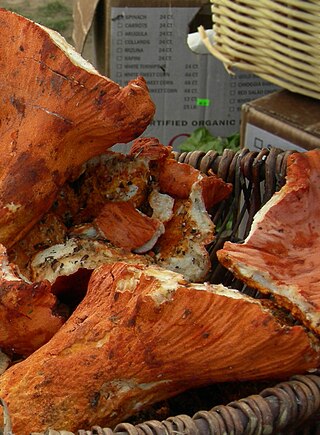
Hypomyces lactifluorum, the lobster mushroom, contrary to its common name, is neither a mushroom nor a crustacean, but rather a parasitic ascomycete fungus that grows on certain species of mushrooms, turning them a reddish orange color that resembles the outer shell of a cooked lobster.

The Mendocino Woodlands State Park is a group camping facility located at 39350 Little Lake Road, Mendocino County, California, seven miles (11 km) inland from the town of Mendocino. It was built as a Recreational Demonstration Area by the Civilian Conservation Corps. Mendocino Woodlands consists of approximately 700 acres (2.8 km2) of land along the Little North Fork of the Big River and is surrounded to the north, east, and west by the 50,000-acre (200 km2) Jackson Demonstration State Forest. To the south, the park abuts the Big River State Park. It was declared a National Historic Landmark on September 25, 1997.
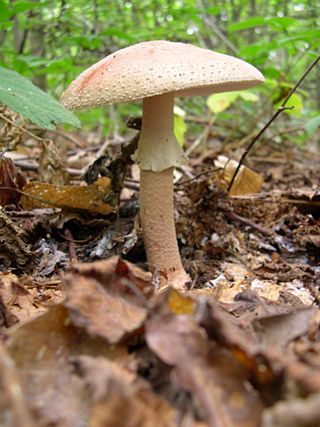
The blusher is the common name for several closely related species of the genus Amanita. A. rubescens, or the blushing amanita, is found in Europe and eastern North America, and A. novinupta, also known as the new bride blushing amanita, is found in western North America. Both their scientific and common names are derived from the propensity of their flesh to turn pink upon bruising or cutting.

The Hypocreaceae are a family within the class Sordariomycetes. Species are recognisable by their brightly coloured perithecial ascomata, typically yellow, orange or red. The family was proposed by Giuseppe De Notaris in 1844. According to the Dictionary of the Fungi, the family has 22 genera and 454 species. In 2020, it was re-analysed and determined to have only 17 genera and about 658 species.

Lactarius deterrimus, also known as false saffron milkcap or orange milkcap, is a species of fungus in the family Russulaceae. The fungus produces medium-sized fruit bodies (mushrooms) with orangish caps up to 12 centimetres wide that develop green spots in old age or if injured. Its orange-coloured latex stains maroon within 30 minutes. Lactarius deterrimus is a mycorrhizal fungus that associates with Norway spruce and bearberry. The species is distributed in Europe, but has also found in parts of Asia. A visually similar species in the United States and Mexico is not closely related to the European species. Fruit bodies appear between late June and November, usually in spruce forests. Although the fungus is edible—like all Lactarius mushrooms from the section Deliciosi—its taste is often bitter, and it is not highly valued. The fruit bodies are used as source of food for the larvae of several insect species. Lactarius deterrimus can be distinguished from similar Lactarius species by difference in the mycorrhizal host or latex colour.

Hypomyces is a genus of parasitic ascomycete fungi found in Europe, North America, Australia, and parts of China. The genus contains 53 species. Better known species include the lobster mushroom and the bolete eater.

Hypomyces chrysospermus, the bolete eater, is a parasitic ascomycete fungus that grows on bolete mushrooms, turning the afflicted host a whitish, golden yellow, or tan color. It is found in Eurasia and North America, as well as southwest Western Australia.

Leotia lubrica, commonly referred to as a jelly baby, is a species of fungus in the family Leotiaceae. L. lubrica was first validly described by Giovanni Antonio Scopoli, but it was later transferred to Leotia by Christiaan Hendrik Persoon. Its relationship with other members of the genus, of which it is the type species, is complicated.
Hypomyces lithuanicus is a parasitic ascomycete in the Hypocreales order. The fungus produces a cream-ochre to cinnamon-colored granular or velvety growth of mycelium on the surfaces of the gills of agaric fungi like Lactarius torminosus, causing them to be deformed.

Xylobolus frustulatus, commonly known as the ceramic fungus or ceramic parchment, is an inedible species of crust fungus in the Stereaceae family. The fruit body forms small, hard, flat crust-like aggregations that resemble broken pieces of ceramic tile. These pieces are initially whitish before turning yellow-brown to gray-brown in age. The spore-bearing cells cover the upper surfaces of the fruit body. A saprobic species, it grows on well-decayed oak wood in Asia, northern Europe, and North America.
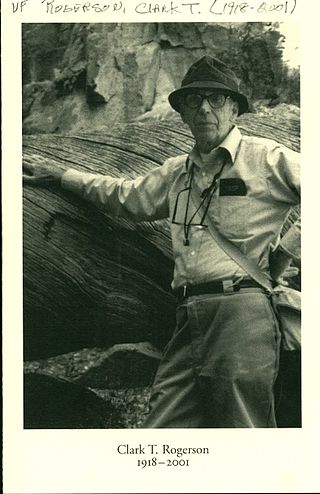
Clark Thomas Rogerson,, was an American mycologist. He was known for his work in the Hypocreales (Ascomycota), particularly Hypomyces, a genus of fungi that parasitize other fungi. After receiving his doctorate from Cornell University in 1950, he went on to join the faculty of Kansas State University. In 1958, he became a curator at The New York Botanical Garden, and served as editor for various academic journals published by the Garden. Rogerson was involved with the Mycological Society of America, serving in various positions, including president in 1969. He was managing editor (1958–89) and editor-in-chief (1960–65) of the scientific journal Mycologia.

Glutinoglossum is a genus of six species of earth-tongue fungi in the family Geoglossaceae. The widespread type species, G. glutinosum, is commonly known as the "glutinous earth tongue". G. heptaseptatum is known only from the Czech Republic. Four additional species were described in 2015.
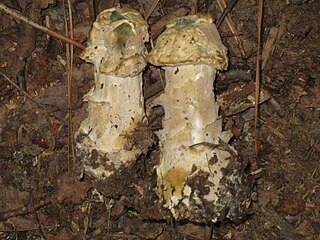
Hypomyces hyalinus is a species of parasitic fungi that attacks fungi of the genus Amanita.

Hypomyces cervinigenus is a parasitic ascomycete fungus that grows on elfin saddle (Helvella) mushrooms in Europe and North America.

Hypomyces papulasporae is a parasitic ascomycete in the order Hypocreales. It was described as new to science in 1985. The type collection, made in New Zealand, was found growing on the ascomata of Trichoglossum hirsutum. H. papulasporae has Sibirina- and Papulaspora-like synanamorphs.
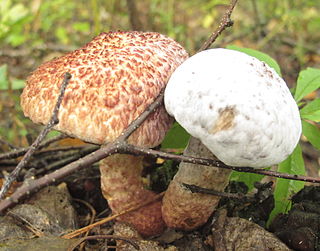
Hypomyces completus is a parasitic ascomycete in the order Hypocreales. The fungus grows on boletes, typically Suillus spraguei in North America, although the type collection was found on growing on Boletinus oxydabilis in Siberia. The color of its subiculum ranges from white initially to yellow-brown to greenish-brown to brown to black; the fruitbodies (perithecia) range from pale brown to dark brown to black. Spores measure 35–40 by 4–6 μm.
Kadri Põldmaa is an Estonian mycologist.
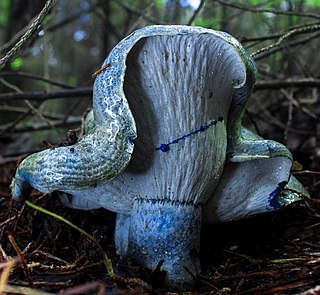
Hypomyces lateritius is a parasitic ascomycete fungus that grows on certain species of Lactarius mushrooms, improving their flavor and densifying the flesh. Hosts include L. camphoratus, L. chelidonium, L. controversus,L. deliciosus, Lactarius indigo, L. rufus, L. salmonicolor, L. sanguifluus, L. semisanguifluus, L. tabidus, L. trivialis, and L. vinosus.
Hypomyces camphorati is a parasitic ascomycete in the family Hypocreaceae. Its host species is Lactarius camphoratus, and it causes a whitish to yellowish subiculum to form on the hymenium of the host, covering and preventing formation of the gills. It also causes deformed cap shape and densifying flesh.















